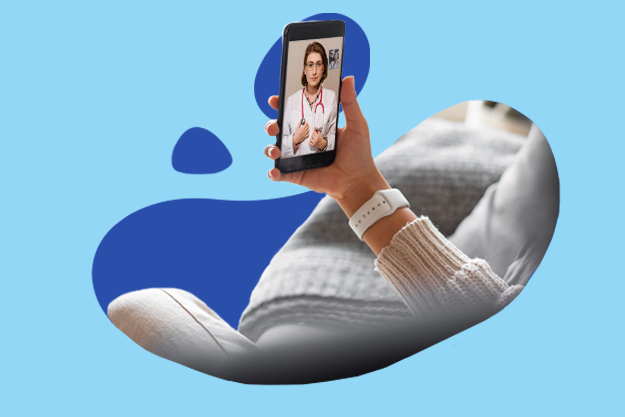From Empathy to EAP: Mental Health Support for Returning Employees
These constantly-changing plans put employees in a precarious position: adding mounting fear, anxiety, stress, and worse to their existing workload.
Connected Navigation Platform
Guiding to high-value care
Behavioral Health
Foster a mentally healthy workplace
EAP
Supporting holistic wellbeing
Virtual MSK Care
Reimagining musculoskeletal care
Virtual Primary Care
Powered by smart navigation
Surgery Centers of Excellence
Best-in-class surgical outcomes
Virtual Urgent Care
Immediate care, any hour of the day
Chronic Care
A new approach to chronic care
Integrations
Flexible to any strategy

There are quite a few misconceptions floating around about virtual care. After over a year of challenging changes — where personal and professional lives moved online — I still find patients who are surprised to learn their health care can be tended to there, too. One of their most common questions is: what can telemedicine treat?
In some ways, the answer is simple. Telemedicine can effectively treat most common medical conditions, with technology mostly limiting its capabilities. That’s good news, given how the pandemic is stretching into its third year.
Let’s dive into what virtual urgent care can treat, what’s excluded from the list, and how we see it evolving over the next few years.
So, when we say telemedicine or virtual urgent care providers can treat most common medical conditions, what do we mean? HealthJoy members are most often treated for sinus infections, upper respiratory infections, urinary tract infections, and skin conditions. These are perfect examples of issues telemedicine can treat quickly, effectively, and without travel. In the early months of 2020, data indicates patient usage increased 33% over the previous year, with large employers offering health plans that cover telemedicine increased by 55% between 2015 and 2019.
In general, if patients have access to virtual health visits, I encourage them to use this benefit, or consider it as a starting point when they’re not sure where to go.
A timely example is a question I think we’ve all encountered since March 2020: is it seasonal allergies, a cold, the flu, or COVID-19? For most patients, it’s hard to parse these symptoms. During a virtual health visit, a medical professional can help you determine if what you’re experiencing warrants a COVID-19 test or a different kind of follow-up. A virtual care visit prevents exposure from coronavirus and its variants during an in-person visit and generally saves time and effort.
Even if you prefer an in-person visit with your primary care provider, there may be times when they aren’t immediately available. Think of the parent whose child is sick late at night or on a weekend. Virtual care provides accessibility at a time when you can’t get in to see your primary care provider and want to avoid costly trips to the emergency room or urgent care facility.
Just as a Zoom meeting isn’t suited for every social event, telemedicine can’t treat every medical situation.
While telemedicine can help you avoid an unnecessary trip to the ER, it isn’t appropriate for life-threatening conditions. If you fear you’re having a heart attack or stroke, or any other life-threatening emergency, you should head straight to the emergency room.
Before the pandemic, online medical providers couldn’t prescribe controlled substances like opioids or the attention deficit hyperactivity disorder (ADHD) treatment, Adderall. However, since March 2020, the Drug Enforcement Agency (DEA) has made a couple changes related to prescribing controlled substances during the COVID-19 public health emergency.
The first change allows providers with prescriptive authority (and within their scope of practice) to prescribe controlled substances through telemedicine. The second change allows qualifying practitioners to prescribe buprenorphine to new and existing patients with opioid use disorder based on a telephone evaluation.
Additionally, there are a few conditions that can’t be effectively diagnosed via phone or video. The most common example I see is ear infections. As a parent, I certainly wish we could find a way to virtually diagnose your little one’s ear infection and get them the relief they need. But this is one of a handful of conditions that, for the time being, have to be diagnosed in person after getting a good look at the eardrum. Luckily, I think this situation is one where we’ll soon see some exciting advancements.
In the future, I think we’re going to see a lot of advancements in at-home diagnostics, testing, and treatment that will make virtual care even more useful for the average person and their family. We’ve already seen telemedicine platforms leverage phone cameras to be able to diagnose skin conditions and rashes. Building off the ear infection example, there are tools that can guide parents to use an otoscope phone camera attachment to capture an image of the eardrum and send it to the doctor. There are other tools that allow a virtual listen of how your heart sounds and trace the rhythm to detect conditions like atrial fibrillation.
The next step will be to increase access to these types of tools so they are readily available at home when you need them. For example, we’ve seen developments in at-home monitoring for sleep quality, heart health, and even dementia. I’m also excited about the development of handheld ultrasound devices and advancements in cloud technology that will enable doctors to remotely monitor patients using these insights.
Another area we can see advancements in is home testing capabilities, which have grown tremendously over the last year in response to COVID-19. After announcing the nationwide vaccine mandate in September, the Biden administration said it’d invest $1 billion in rapid at-home Covid-19 tests, geared at expanding the availability of such products in the coming months. More clinicians are working with at-home tests, and more companies are providing innovative solutions to expand in-home testing. I think we can expect to see much more innovation in terms of what telemedicine can treat in the very near future.
So, to wrap it all up, telemedicine can treat any non-life-threatening medical condition for which a clinician’s guidance would be helpful. Telemedicine is a great first-line option that lowers barriers to care, saves you time, money, and hassle over an in-person visit.

These constantly-changing plans put employees in a precarious position: adding mounting fear, anxiety, stress, and worse to their existing workload.

You might guess that tackling 2021 open enrollment amid this year’s upheaval would require an innovative approach. Yet as our 2021 State of the...

“New normal.” It’s a refrain that’s now part of our collective vocabulary (much to our chagrin). It’s true haven’t seen anything like the COVID 19...